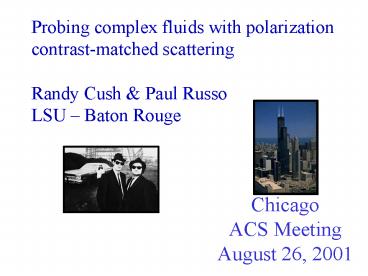Probing complex fluids with polarization contrast-matched scattering Randy Cush - PowerPoint PPT Presentation
1 / 32
Title:
Probing complex fluids with polarization contrast-matched scattering Randy Cush
Description:
Probing complex fluids with polarization contrast-matched scattering ... 10 decades of time in one measurement! Contrast stinks: everything scatters, esp. ... – PowerPoint PPT presentation
Number of Views:31
Avg rating:3.0/5.0
Title: Probing complex fluids with polarization contrast-matched scattering Randy Cush
1
Probing complex fluids with polarization
contrast-matched scatteringRandy Cush Paul
RussoLSU Baton Rouge
Chicago ACS Meeting August 26, 2001
2
Study of Complex Fluidsby DLS Prospects
Problems
- Wide-ranging autocorrelators
- gt 10 decades of time in one measurement!
- Contrast stinks everything scatters,
esp. - in aqueous systems where refractive index
matching cannot hide matrix.
3
Solution Use Polarizers to Hide Matrix
4
Dynamic Light Scattering Setup
Uv Geometry (Polarized)
?
V
?Uv q2Dtrans
Hv Geometry (Depolarized)
?
V
H
?Hv q2Dtrans 6Drot
5
ZADS PTFE latex microrheology of polyacrylamide
gel
See also Piazza, Tong, Weitz
6
(No Transcript)
7
Strategy
- Find polymer that should entangle
- Random coil
- Polysaccharide
- Invisible in DDLS
Dextran
- Find polymer that should not entangle
- Highly-branched
- Polysaccharide
- Invisible in DDLS
Ficoll
- Find a rodlike probe that is visible in DDLS
- Rigid rod
- Virus
- Visible in DDLS
TMV
- Measure its diffusion in solutions of each
polymer separately
8
Doing our Part to Keep the A in LSU AM
Seedlings? Sick Plants ? And close-up of mosaic
pattern.
9
TMV Characterization
- Sedimentation, Electron Microscopy and DLS
- Most TMV is intact.
- Some TMV is fragmented
- (weaker, faster mode in CONTIN)
- Intact TMV is easy to identify
- (stronger, slower mode in CONTIN)
10
11
Hv correlation functions for 14.5 dextran and
28 ficoll with and without added 0.5mg/mL TMV
- The dilute TMV easily outscatters both matrices.
12
13
(No Transcript)
14
(No Transcript)
15
Stokes-Einstein Plots if SE works, these would
be flat. Instead, deviations in different
directions for Drot and Dtrans
16
(No Transcript)
17
(No Transcript)
18
(No Transcript)
19
Too-Good-to-be-True Conclusion?
- Below 6.5 dextran the diffusion of the rodlike
TMV probe is controlled mostly by viscosity. - Above 6.5 dextran a sharp transition suggests
topological constraint for TMV rotation while
translation is not much affected. - The transition is more gradual in ficoll.
- The TMV probe senses something different for
linear vs. highly branched polymers in solution. - Looks good for topological models!
20
Alternate Conclusion?
- The systems studied so far place (impossibly?)
strict demands on geometric polarization
alignment. - Revised polarization placement
- Difficult zero angle measurements requiring even
more TMV - New systems must be studied
- TMV is OK
- Dextran/Ficoll must go!
- Depolarized probe diffusion has the potential, as
yet unrealized, to assess strength of
hydrodynamic vs. topological effects.
21
Thank you!
Randy Cush David Neau Ding Shih Holly
Ricks Jonathan Strange Amanda Brown Zimei
Bu Zuhal Savas Kucukyavuz--METU Seth
FradenBrandeis Nancy ThompsonChapel Hill
NSF
22
(No Transcript)
23
The chiral dextran and ficoll alter polarization
slightly before and after the scattering
center. Sign magnitude of Stokes-Einstein
failures depend on how one handles this tiny
effect.
24
Misalignment from thick polarizer in active
part of detector train, exacerbated by tiny
cellsused to squelch optical rotation conserve
TMV
25
Conditions for use as a Probe
- Is the TMV Probe Dilute?
- A TMV concentration of 0.5 mg/mL, well below the
theoretical overlap concentration, was chosen.
See Figure 2. - Does dilute TMV overwhelm the matrix scattering?
- At 0.5 mg/mL the TMV easily outscatters both
matrices. See Figure 3. - Is the probe compatible with the matrix?
- -Solutions stable months after preparation
- -Angle dependent Hv SLS
- -Dtrans goes up, not down (Figures 6 8)
26
Effect of Dextran Concentration
- The dependence of Drot and Dtrans upon added
dextran is shown in Figure 4. - The quotient Drot/Dtrans is plotted against
viscosity in Figure 5. By combining both
transport coefficients, each inversely
proportional to viscosity in dilute solution, we
can remove the effect of solution viscosity. - Figure 6 reveals like positive deviations from
the Stokes-Einstein continuum expectation that
diffusion be inversely proportional to viscosity
(below 6.5). - Above 6.5 the deviations become greater for both
Drot and Dtrans but in opposite directions
27
There once was a theorist from France who
wondered how molecules dance. Theyre like
snakes, he observed, As they follow a curve,
the large ones Can hardly advance. D M -2
de Gennes
P.G. de Gennes Scaling Concepts in Polymer
Physics Cornell University Press, 1979
28
Doi-Edwards-Onsager Reference Volumes for Rods n
number density of rods per unit volume
LC formation n 4/A2 ? 5/dL2
Reduced Density n/n ? ndL2/5
29
Outline
- Characterize the TMV
- Is it intact and behaving properly?
- Establish conditions for use of TMV as probe
- Can the probe be dilute and still overwhelm the
matrix scattering? - Will the probe stay mixed with the matrix
solutions without aggregating? - Show the effect of the dextran and ficoll
matrices on TMV diffusion
30
(No Transcript)
31
(No Transcript)
32
Effect of Ficoll Concentration
- The dependence of Drot and Dtrans upon added
dextran is shown in Figure 4. - The quotient Drot/Dtrans is plotted against
viscosity in Figure 7. - Figure 8 shows slight like positive deviations
from the Stokes-Einstein continuum expectation
(below 11). - Above about 11 ficoll the deviation slowly
becomes greater for Drot and slightly greater for
Dtrans but in opposite directions - Figure 9 compares TMV behavior in ficoll to that
in dextran.































